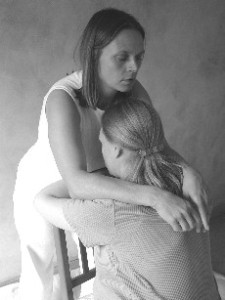I always love to hear from people who have attended my courses, as it is important for me what they do after they have studied. I was checking details on my register of practitioners and spoke to Carol Falaki (previously Eames), who attended my Shiatsu for Midwives course in 2001. I now call it “Shiatsu and maternity care” as I have opened it to doulas, pregnancy massage therapists, antenatal teachers and other maternity professionals interested in learning about how to incorporate shiatsu into their work. She is now retired but was telling me how happy she was that she had done my course and while she was still working she had been able to integrate some of what she learnt with me.
She wrote an article for the British Journal of Midwifery, BMJ vol 12 no7 p447-450, under her name Carol Eames. You can view the abstract . She has also written about sacral massage for pregnancy ( p103) and during birth (labour) (pages 145 to 154 and p200 ) in her book ” Birth in Suburbia” .

General pressure on the sacral points: From Beautiful Birth by Suzanne Yates
” It was an enjoyable and rewarding course. I subsequently found there were many ways to safely incorporate shiatsu into my professional practice to the benefit of the women in my care.
The Labour in Motion classes referred to in the BMJ article included teaching the birth partner some simple massage techniques. I spent time in each session showing the birth partner how to locate and use the shiatsu technique on the sacral points. I know this works well. I used the same points on my daughter for her two home births with good effect.
Most importantly having acquired these skills the women and their partners felt empowered.
The slow ‘waterfall’ back massage I learned on your course was excellent when given to women feeling tense during breast-feeding, and an easy one for the partner to learn.
Another useful pressure point for antenatal care was Neiguan P6 .

Shiatsu shoulder work, from Shiatsu for Midwives by Suzanne Yates
I also used the placenta points (Gall Bladder 21) for retained placenta. This worked well and one registrar, who had been about to take a lady to theatre, was so impressed with the the result that she sent someone to find me the next time she encountered the same problem.
Unfortunately I was subsequently advised by my supervisor that due do to a lack of research evidence I should not perform this simple shiatsu technique…very frustrating.
I produced a booklet on shiatsu massage and pressure points with simple illustrations which was distributed to my colleagues a number of whom incorporated some massage into their intra-partum care.
Although I am now retired from midwifery I have been told by past colleagues that aspects of the Labour in Motion sessions are still incorporated into the antenatal classes locally.
My book Birth in Suburbia by Carol Falaki (my married name) is available as a paperback or for 99p via Kindle.
There is a rather nice review by Kim Thomas:
Traditional advice to new authors is to write about what you know and Carol Falaki has certainly taken that to heart. A midwife for 19 years, and a mother of two, her novel Birth in Suburbia follows the lives of three friends in their journey from late pregnancy to giving birth…….Falaki is obviously familiar with the concerns that women have in pregnancy -their fear of giving birth, their worries about whether they will be able to breast-feed and their anxieties about relationships. She knows what pregnant women talk about, and offers a good account of the conflicting views about whether home birth is better than hospital birth. She is also excellent at showing the confusion women feel when confronted with so much contradictory advice. The author comes into her own when relating the very different birth experiences of the three women. Her descriptions of a home birth, a relatively straightforward hospital birth and a difficult hospital birth ending in an emergency Caesarean are realistic and packed with the kind of detail, both about the physical experience and the emotions of the women themselves that only an experienced midwife could convey…
Full review by Kim Thomas; New Digest, NCT professional, Edition 49



